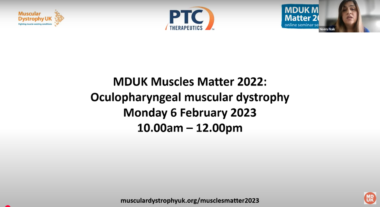Our condition-specific alert cards provide crucial information for emergency healthcare professionals treating patients with muscle wasting conditions.
Oculopharyngeal muscular dystrophy (OPMD)
Oculopharyngeal muscular dystrophy (OPMD) is a rare genetic condition that causes progressive muscle weakness. It mostly affects the muscles around the eyes (oculo) and throat (pharyngeal), but weakness in the arms and legs can also occur. Symptoms of OPMD don’t usually develop until after the age of 40, with the average onset age being around 50 years of age.
The first symptoms of OPMD are either drooping eyelids (ptosis), or difficulty swallowing (dysphagia), in adulthood. This happens because OPMD weakens the muscles that control eye movement and swallowing.
Eyes
As the eyelids droop (ptosis), the eyelid may begin to cover the pupil of the eyes, reducing the field of vision. However, this doesn’t affect the structures that send visual information from the eyes to the brain (the optic pathway). The drooping of the eyelids is caused by weakening of the levator muscle in the upper eyelid. While OPMD doesn’t affect the parts of the eye that sense light, weakness in the muscles controlling eye movements can occur. This may mean that the eye moves less, and so more head movement is needed to look around. People with OPMD may often tilt their head backwards or overuse their forehead muscles to compensate for drooping eyelids. Some people can experience double vision (diplopia). A reduced field of vision, or double vision, can cause poor balance.
Swallowing
Difficulties swallowing (dysphagia) progress slowly. Problems may start with dry or tough foods such as meat. Sometimes food can feel stuck, and a gulp of water is needed to clear it. Coughing and choking can also occur. Some people may experience salivary drooling due to delayed swallowing. In severe cases, the ability to drink liquids and swallow saliva may be affected.
Dysphagia can make it difficult to eat as much as is needed for dietary requirements. Food or drink can sometimes go “the wrong way” and down the windpipe. This can cause chest infections, which can occasionally be serious.
Limb weakness
Many years after these initial symptoms, limb weakness may develop. This can start around the shoulders first, and later around the hips. This is often mild but can progress in severity and impact mobility.
Genetic changes
OPMD is caused by changes in the PABPN1 gene. This gene provides instructions to make the PABN1 protein. A change in the gene means that an abnormal protein is produced and builds up – especially in the muscles of the eyes and throat. This causes muscle weakness.
Inheritance
We have two copies of most genes in our cells. In OPMD, only one changed copy of the PABPN1 gene will cause the condition, even if the other copy of the gene is working fine. As a result, OPMD is inherited in an autosomal dominant inheritance pattern. This means that the child of a person with OPMD has a 1 in 2 chance of inheriting the condition. It’s possible that some people in a family affected by OPMD are carrying a changed copy of the gene but have not yet developed symptoms.
For more information, see our inheritance and genetics page.
A GP can make a referral to a neurologist, or local clinical genetics service for review, if there are symptoms of OPMD or family history. A neurologist is a doctor who specialises in conditions that affect the muscles and nervous system. OPMD is usually diagnosed with a medical assessment and a blood test. The blood test can identify the changed gene. In the past, muscle biopsy was often performed, but this is now rarely done as the genetic test is easy to do and highly accurate.
For more information, see our diagnosis page.
A multi-disciplinary approach, which involves healthcare professionals working together, is important in not only managing the condition and symptoms, but in improving wellbeing too.
Some changes in lifestyle and surgery can manage and improve the two main symptoms of OPMD. There is currently no cure for OPMD.
Access to a healthcare team
People with OPMD should have access to a neurologist and a specialist neuromuscular clinic to monitor their condition. Other health professionals can also help when needed. Physiotherapists can help with movement and strength, occupational therapists can help with everyday tasks, and speech and language therapists can help with swallowing and communication. If you do not have contact with a neurologist or specialist doctor, speak to your GP about getting access.
Ptosis (droopy eyelids)
Several options are available to help with ptosis. In the first instance, a small device called a “prop” or a “loop” that fits on to a pair of glasses may be offered, which can hold the eyelid up.
Surgery is available for ptosis and can be very successful. The need for surgery to treat ptosis will depend on severity and how much it affects a person’s vision. This is done by an ophthalmologist, who specialises in eye health, or an oculoplastic surgeon, who specialises in surgery for the eyelids and surrounding areas.
The surgery involves shortening the muscle and tendon that raises the eyelid. Surgeons should tailor the procedure to the person. It’s usually done under local anaesthetic. The aim is to significantly reduce eyelid drooping, maintain symmetry, and improve field of vision while ensuring the eye can still close properly. Speak to a neurologist or GP to discuss if this is a suitable option. There are other surgical options that can be considered if needed.
Dysphagia (swallowing difficulties)
A neurologist or GP should refer people struggling with dysphagia to a speech and language therapist, who can help with swallowing techniques, and a dietitian, who can advise on safe food and drink choices.
A speech and language therapist can assess dysphagia and provide swallowing therapy. Swallowing therapy includes exercises to maintain as much swallowing function as possible. Strategies to avoid complications while eating include taking time with meals and avoiding talking. OPMD can also affect clarity and volume of speech. A speech and language therapist can provide strategies to help keep speech as clear as possible.
A dietitian can suggest dietary adjustments to prevent choking and ensure adequate nutrition. This might mean eating softer foods or using thickeners in liquids. If unplanned weight loss occurs, they may suggest food supplements or high-calorie drinks. In severe cases, a liquid diet may be necessary. If dietary changes don’t help and swallowing problems get worse, a gastrostomy may be recommended. This involves creating a small hole in the abdomen through to the stomach and inserting a feeding tube, known as a PEG (Percutaneous Endoscopic Gastrostomy) or a RIG (Radiologically Inserted Gastronomy). Liquified food and water can then be directly put into the stomach so that nutritional requirements are met. Some people may still be able to eat and drink small amounts through their mouth if they wish to. A speech and language therapist will help with this decision, balancing quality of life and safety.
If dysphagia is severe, and swallowing therapy doesn’t help, surgery to widen the oesophagus may be considered. Surgeons make an incision in the cricopharyngeal muscle just above the oesophagus in a procedure called cricopharyngeal myotomy. Similar, but more temporary results can be achieved with Botox injections to the same muscle. The injections relax a muscle at the top of the throat. These procedures are usually done by an Ear, Nose, and Throat (ENT) surgeon. A doctor can advise on the most suitable option.
Limb weakness
Staying as active as possible is important. Physiotherapy can be beneficial for managing muscle weakness in the limbs. A physiotherapist can come up with exercises for a person to do independently to make the most of their strength. If possible, it would be good to see a specialist neuromuscular physiotherapist. To find out more about advice for adults, see exercising with a muscle wasting condition. As muscle weakness progresses, mobility aids may be helpful, and these can be discussed with a physiotherapist.
If day-to-day tasks become difficult, an occupational therapist can suggest practical solutions and provide mobility aids and equipment to make things more manageable at home and at work. A referral can be made by a GP or neurologist, and some local council’s allow self-referral.

Author: Muscular Dystrophy UK
Reviewers: Dr James Lilleker and Dr Charlotte Dougan
Last reviewed: February 2025
Next review due: February 2028
Oculopharyngeal muscular dystrophy webinar (2023)
On Monday 6 February 2023 we held a webinar on OPMD. Watch to learn about the latest research, as well as tips and advice on living well with OPMD.

We are here for you
Webinars, Information Days, and support groups for our muscle wasting community. Our life-changing support is here for you.
Advice for living with or caring for someone with a muscle wasting condition.

